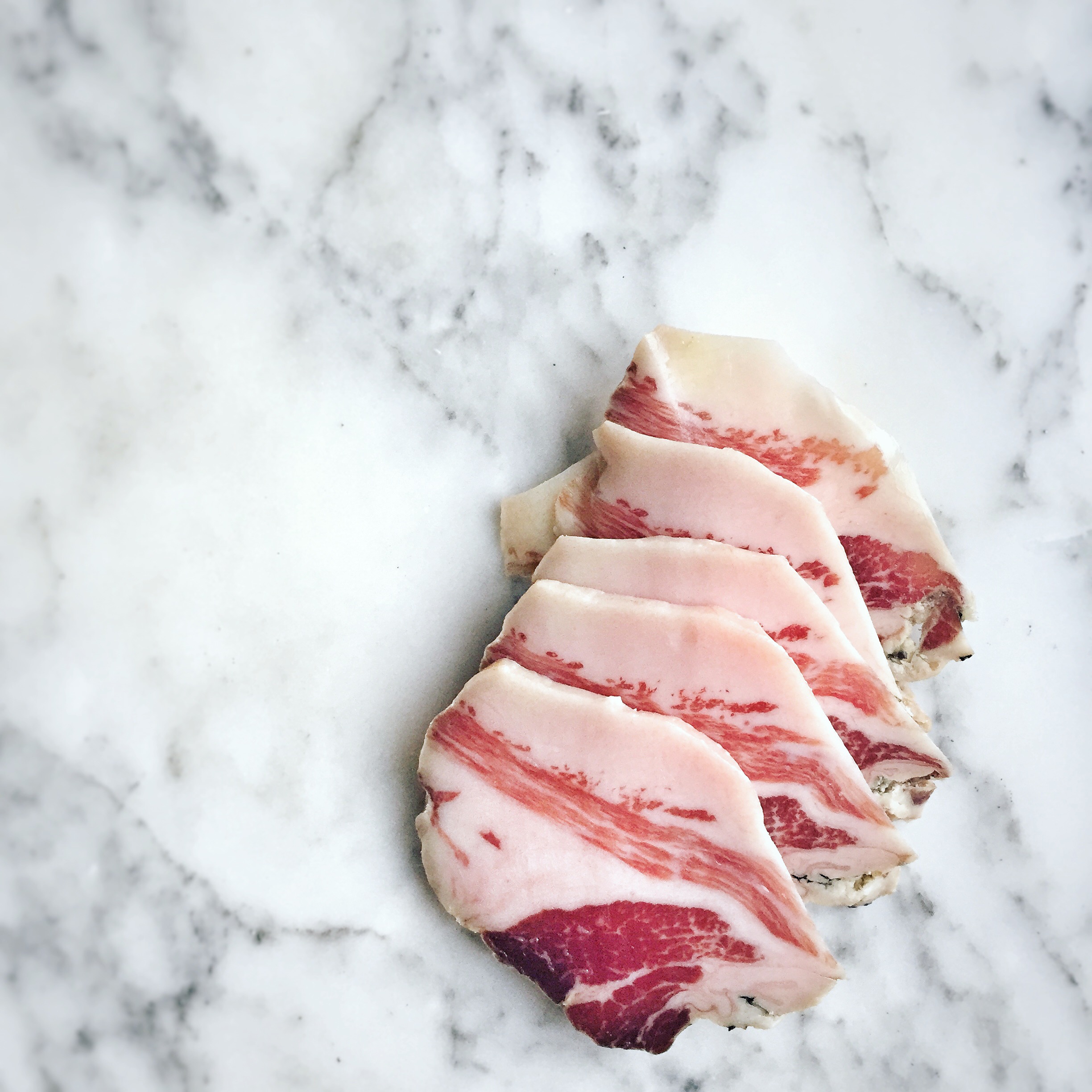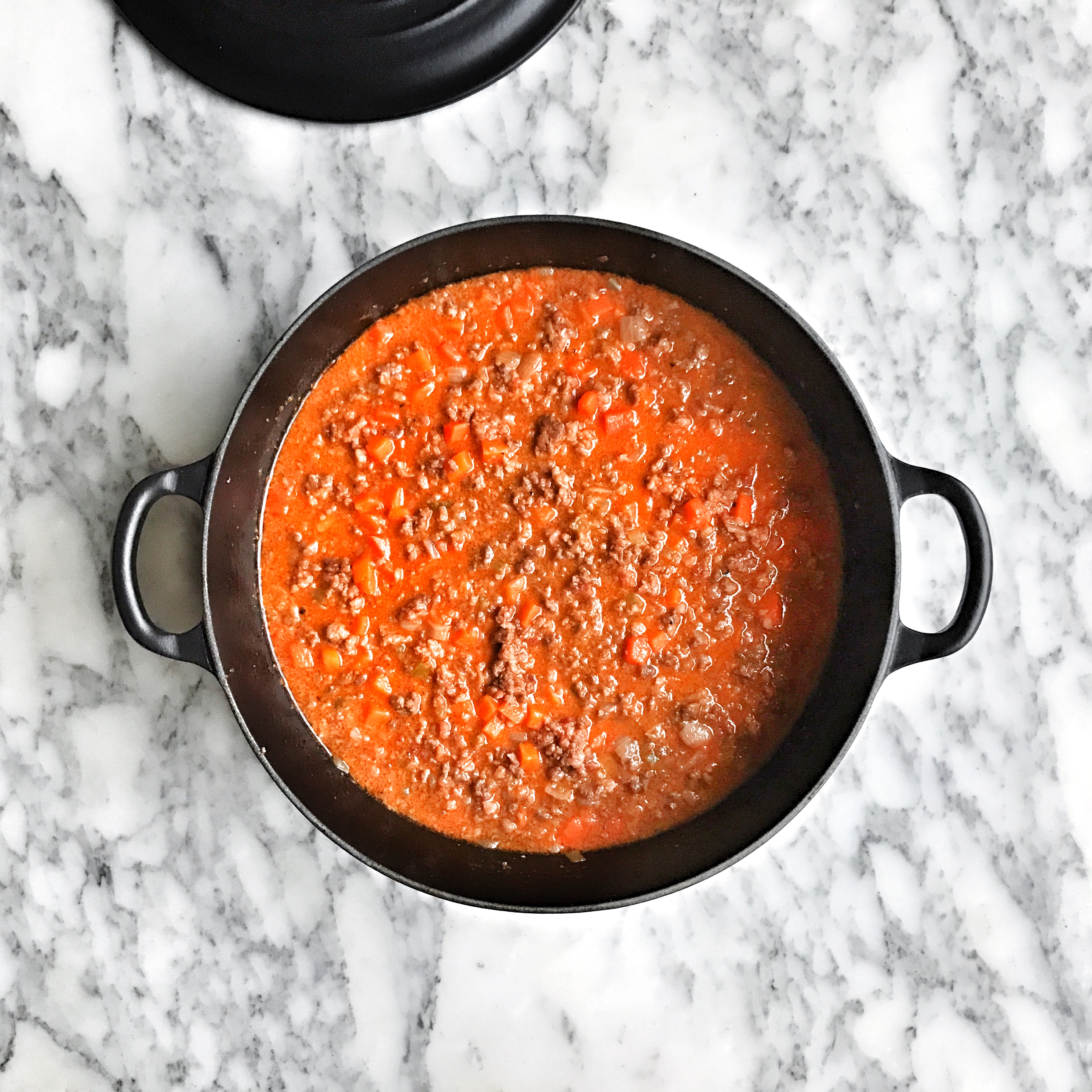
Family Food: Ragu alla Bolognese 2.0

Ten years ago, I road tested an earlier version of this ragu alla Bolognese recipe for the very first time. It has since become a household staple; the recipe that defines ragu alla Bolognese for my family. For the moment, it is also the only pasta dish both my children will eat. They clamour for it every week. And I must admit that listening to my two-year-old pronounce “boh/loh/NYEH/seh” makes me smile.
However, my taste preferences and lifestyle have changed over the years. Having prepared this ragu for a decade, I’ve jotted down many details that have helped me to more consistently achieve the final outcome I’m after. This was what prompted me to share a version 2.0 recipe with you (10 years of recipe notes!).
That said, I don’t claim to know what an authentic or traditional version of ragu alla Bolognese is. This is simply the way my family enjoys it.
Personally, I’ve also written this all down because I hope to give my children a chance to re-live the memory of this taste of their childhood in the future. The magic of a recipe is that it breathes life into a remembered past long after its author loses the capacity to rewrite it in her own words.
Toby and Tara, if you do ever read this, know that mama loves you always and forever.
Lessons Learnt
For one, I find the use of butter in addition to olive oil unnecessary. This is especially so because the pork belly and guanciale provide adequate fat to the dish. The same applies to the quantity of cream. Where I initially celebrated it for taking the mild acidic edge off the tomatoes, adding a full measure of cream to the ragu eventually made it too cloying. Eating it began to feel like an extreme sport! I’ve since reduced quantities and started using sour cream or creme fraiche instead. I like how they enrich the ragu while sustaining balance. The faintest hint of acidity helps cut through the overall unctuousness of the dish.

I’ve recently started to add leeks to this ragu, too. I love how they melt into the dish and add a vegetable sweetness to it. Should they turn out to be a hassle for you to pin down, then substitute them with two more brown onions.
I’ve also discovered that using canned cherry, rather than Roma, tomatoes adds a desirable sweetness and umami to this recipe. Furthermore, cutting down the quantity of tomatoes a little and eliminating the beef stock leaves us with an aptly reduced ragu that clings well to pasta, and boasts a deliciously calibrated intensity of flavour.
As for the use of wine, it’s a bit of a superstition for me. I’m convinced that it builds a layer of nuance. But I tend to reach for whatever leftover wine I happen to have in the freezer. While a dry white is preferred, I’ve used everything from fruity reds and champagne, to even vermouth or cognac (in a smaller quantity). On occasion, I use a blend of leftover wines.
Finally, I feel that the kind of salt and pepper you use also matters. In a dish that boasts such luscious flavours, I like that Red Boat salt contributes yet another facet of near-funky umami savouriness to the ragu. My preference is to use freshly crushed Kampot black pepper, which isn’t about outright heat. I find it aromatic and subtle. Yet, it manages to hold its own among a melange of flavours.
Convenience Versus Flavour
In my quest to develop a more concise ragu recipe, I’ve attempted to use store-bought minced meat. But it never delivers on mouthfeel and flavour (probably because the cuts that go into store-bought minced meat aren’t always meant to be slow cooked). The meat ends up tough and grainy rather than tender, and the ragu ends up tasting thin and watery.
So, I do two things. First, I choose the cuts of meat carefully (at present, I favour Canadian pork belly and Australian oyster blade) and have it ground at the butcher’s or I do it myself at home. Second, I double the recipe (the recipe below yields twice the original) to make the amount of time I put into making it worth my while.
I’ve also tried making this in a crockpot in the hopes of easing the need to watch over it constantly. But after multiple attempts, I’ve concluded that the crockpot fails to deliver the same vivacious flavours (it takes a lot longer to reduce). Using an induction hob makes it the most manageable. Also, using a cartouche seems to help pace the reduction of the liquids. It ensures that the meat develops tenderness even as we reduce moisture to intensify flavour.
This feels like a tiresomely long recipe, but it really isn’t. I often get all the prep done (grind the meat, chop the vegetables, process the canned tomatoes) on one night. I store everything in the fridge and make the ragu the following night. The family then has it for dinner the night after.
I totally believe that slow cooked dishes taste better the day after they’ve been made. (Aged ragu, anyone?)
You are the most important part of the recipe
My attitude towards recipes has also changed over the years. Recognising how variable ingredients can be, a recipe can only be a rough road map. The cook plays a major role because you select every component of the dish.
So, where I used to keep ingredient specifications as broad-stroked as possible to accommodate differences in produce availability, I now tend to be exceedingly specific. Even if you can’t lay your hands on the ingredients I use, they give you a stronger sense of how you might tweak or substitute items to create a closer approximation of what the recipe seeks to accomplish.
It isn’t about using the most expensive ingredients. Paying close attention to all aspects of the dish is what it takes. Everything from your choice of ingredients, to the type and size of pot you use, your heat source and even your frame of mind comes into play. Keep tasting as you go so that you can tweak and adapt the dish as it evolves.
It would be quite terrifying, and unnatural, for ingredients to remain exactly the same all year round. I’ve learnt to embrace the inexactitude of nature and humanity as part of our process.
Ragu alla Bolognese 2.0
Makes 16 portions
400g guanciale
800g oyster blade steak
800g Canadian pork belly, skin off
3 leeks, white stalk only
2 brown onions, peeled
4 medium carrots, peeled
4 ribs celery
3 cans (each 400g) cherry tomatoes, drained
Olive oil
1 cup dry white wine
1tsp Red Boat salt, or to taste
1/4 tsp whole Kampot black peppercorns, crushed
Freshly grated nutmeg, to taste
200ml sour cream/creme fraiche
Slice the guanciale, beef and pork into narrow strips that will fit into you meat grinder chute. If you find it difficult to slice the chilled meat, place the whole pieces of meat in the freezer. When they are semi-frozen, cut them into narrow strips. Then freeze the strips. This can make them easier to grind. Coarsely grind all the meat together in a meat grinder. Set aside in the refrigerator.
Chop the leek, onions, carrots, and celery stalks to a 1cm dice. Press drained canned tomatoes through a food mill (using the disk with the smallest holes) into a bowl made of non-reactive material (such as glass). Don’t include the liquid that the tomatoes are steeped in because it will leave you with too much moisture in your sauce.
At this point, start working on your battuto. Heat just enough olive oil to coat the base of a large, heavy-bottomed pot (I use a 30cm cast-iron French oven) over medium heat. You can tell when the pot has achieved the right temperature by observing the oil. It should seem more fluid, transforming into an even slick across the pan without puddling.
Toss in the leeks and onions first. Sweat them (they should be translucent, but not browned). Toss in the remaining vegetables. Continue to sweat until they begin to soften before adding the minced meat mixture. Sauté, stirring occasionally with a wooden spoon, until the meat is browned (about 10min).
Add the wine into the pot and let it evaporate for 5 minutes (increase the heat a little if necessary). Add the tomatoes and simmer uncovered for another 20 minutes. Season to taste with salt, pepper and nutmeg. Cover with a cartouche (here’s why) and simmer for 45 minutes. Stir in the sour cream, lower the heat and reduce uncovered for another 25 minutes. The final ragu should not be too watery. You want it to cling to your pasta when you serve it.
I usually cool the ragu and pre-portion it into multiple bags (usually helpings for 2 adults or 2 children simply because that works for our household). These are stored frozen in vaccuum sealed bags. I know fresh is best, but there is a limit to how much of a slow-life my working mom-life affords me. I make calculated compromises.
To serve, heat ragu in a saucepan (add a little chicken stock if you need to adjust the thickness of it), then add cooked pasta of your choice. Stir to coat evenly and heat through before plating. Top with generous shavings of Parmigiano-Reggiano or Grana Padano.
About Su-Lyn Tan
Su-Lyn is Aun's better half and for many years, the secret Editor behind this blog known to readers simply as S. Su-Lyn is an obsessive cook and critical eater whose two favourite pastimes are spending time with her three kids and spending time in the kitchen. She looks forward to combining the two in the years to come.


Made this recipe this wkend…have been looking around for a bolognese recipe…interesting recipe firstly because of the 3 types of meats used…secondly, the draining of the tomato juice and lastly the use of sour cream to round off the finish dish….there is a unique smell of the meats when it’s cooking….the fats releases is either a love it or hate it smell….there is a sweetness of the finished product and the sour cream adds a velvety taste to it…,this is a different alternative to butter which also lends a very different dimension to the dish….it’s a very satisfying dish to prepare and it’s a keeper…many thanks..
Where can one find guanciale and oyster blade steak in Singapore.